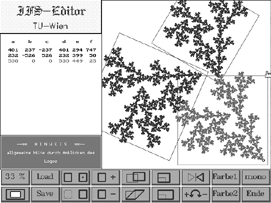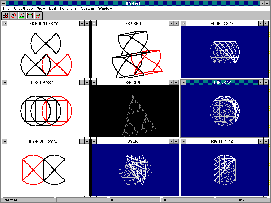Nonlinear Iterated Function Systems
project duration: 1993-1994
An Iterated Function System (IFS) specifies a discrete dissipative dynamical system. An IFS consists of a set of contractive functions which define a more complex contractive function W(). Due to the contractivity of W() it can be shown that there is a unique attractor A' that satisfies A' = W(A') Furthermore any set A will be eventually mapped onto this attractor A' under repeated application of function W(). Usually contractive affine transformations are used for the specification of an IFS. The existence and uniqueness of attractor A', however, depend on the contractivity of the functions but not on their affinity. The usage of nonlinear functions increases the flexibility when defining Iterated Function Systems. Affine transformations may be specified by defining a simple object (e.g., triangle, rectangle in 2D) and defining the corresponding transformed object. Nonlinear functions are defined (in analogy to the above approach for affine functions) by grid distortions. Starting out from a regular grid, grid points are transformed according to user specification. The transformation of intermediate points is done through interpolation of surrounding grid points.
Above an interactive program for the specification of 2D linear and nonlinear Iterated Function Systems is shown. The definition of hierarchical IFS and the specification of LR-tables (language restriction tables) is integrated into the system. An LR-table controls the application of individual functions during the "stochastic algorithm" that is used for fast visualization of the fractal limit set. The user interface allows a fast and convenient specification and modification of Iterated Functions Systems. The user gets an immediate feedback of the effect of his modifications on the outcome.
An interactive program for the specification of 3D nonlinear Iterated functions Systems was implemented as well. Ray tracing which is a time consuming high quality visibility method was adapted to render these geometrically highly complex objects.
To download the software for 2D IFSs press 2D-IFS-Editor (PC, Dos, uncompress with pkunzip -d). Further information is given in the following technical reports:
- Modeling and Rendering of Nonlinear Iterated Function Systems
- Interactive Design of Nonlinear Functions for Iterated Function Systems

This page is maintained by Eduard Gröller. It was last updated on November 20, 1998.
If you have any comments, please send a message to edi@cg.tuwien.ac.at.





